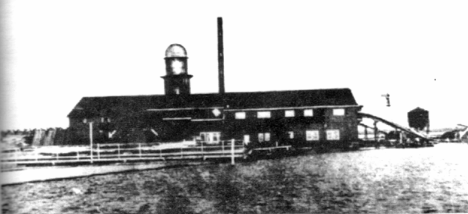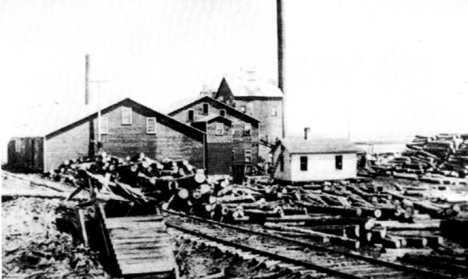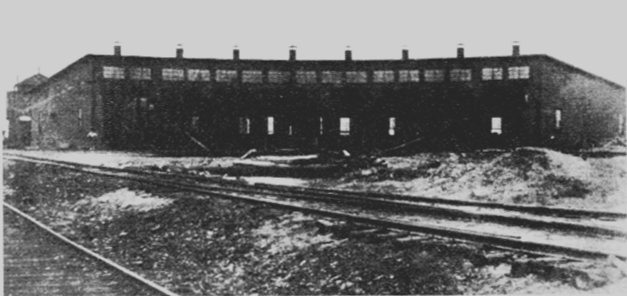|
Zemple Deer River's Industrial Suburb
From The Deer River
Centennial History, Published in 1998

The big sawmill in Zemple
During the early 1900s, Zemple was a busy
lumber town. There was a sawmill and planing mill operated
by Itasca Lumber Co., a box mill operated by Rathburn, Hair
& Ridgeway Co., and a veneer mill operated by Bahr Bros.
There was a roundhouse, a boarding house, and a population
of more than 300 people. To get to Zemple requires a drive through
the south end of Deer River, past the athletic field. There
are several streets (each about two blocks long) and a road
going down to the public landing on White Oak Lake. Today it
is a quiet residential community with a population of about
62 people. "You can call us anything, even late for supper,
but don't call us a suburb of Deer River,- said Bazil Mayo,
who at 80 is the oldest lifelong resident of Zemple. His
wife, Dorothy Simons Mayo, is another lifelong resident of
this small city and currently serves as the city clerk. Officially organized in 1911, the first
council meeting was held in June of that year. A May 6,
1911. item in The Itasca News
reported county board news as
follows: "A Village Wanted at the Deer River Mill. Supt.
Wallace presented a petition asking for an election to make
a village of that part of Otenagon Township lying south of
the village of Deer River. The petition was granted. This
does not constitute separation from the township. but it is
considered a preliminary move toward that end." The
Itasca News of March 16, 1912, reports an election in
which 24 votes were cast in this "milling suburb to the
south of Deer River." Elected were President. R.T. Zempel;
trustees, J.P. Martindale, Ole Berg, Jonathan Martindale;
clerk, D. Zetterstrom; treasurer, Emil Krantz; assessor,
Morris Larson; justice, A.W. Rice; constable, John Larson.

The old road to Zemple
Early Zemple was a place where the Minneapolis & Rainy
River Railway had a roundhouse with 12 engines. "Those
trains would bring logs from all the logging camps back to
the mills in Zemple," said Bazil Mayo. He remembers that
Zemple had a store, a school (which closed in 1928), and a
church. There were no saloons in Zemple. Those could be
found a short distance away in the Village of Deer River. Residents of Zemple had small pieces of land, and many
had cows, chickens, and other livestock and raised gardens
to help feed their families. There were plenty of chores for
young people. Bazil Mayo remembers carrying water, cleaning
barn, and chopping wood. Hay was made on the meadows. Others cut and sold tamarack
wood from state and federal land. There were no water and
sewer systems. Even today residents have their own wells but
are now connected to the Deer River sewer system. By the late 1920s the lumber industry no longer
flourished on the shores of White Oak Lake. There was a
public access on the shore where millions of logs had been
floated down river in earlier days. It was a popular fishing
spot. Mayo remembers small boathouses along the White Oak
lakeshore. where people would tie up and leave their boats
until the next fishing trip. The town was named for R.T. Zempel, who owned most of the
land and was elected the first village president. The
Zempels had a farm on the south edge of the village that in
a 1912 article in the Deer River newspaper was referred to
as the Sullivan farm. Later a Martindale, Gordon Laumann
(who raised mink) owned it, and then the Reed family lived
there for many years. Other early residents of Zemple
included Martindales, Mayos, Simons, Nordahls, Dahls,
Spragues, Johtonens, Nellis, Robertson, Blum. Reed, Folsom.
Ellis, Newkirks. Wrights, and Berghs. The earliest council meeting minutes date from April 1926
and at that time the spelling was Zempel, but on June 8,
1926. the spelling was changed to Zemple. There is no indication of official action of
any kind regarding this. Susie Bergh was clerk at that time.
Most council meetings were held in homes. In 1929 Custer
Thydean became clerk and he used the "Zempel" spelling while
recording one meeting, but changed it the
following month. It would seem that the early minutes and
records of Zemple were lost, as an entry in the minutes of
September, 1931. asks if these could be located. In a May,
1939, Quit Claim Deed, the Itasca Lumber Co. leased land to
the village of "Zempel" but the lease was signed by village
officials as "Zemple." R.T. Zempel's daughter. Harriet Zempel Crabtree, writes:
"As usual. the name Zempel, is misspelled, even on a map of
Minnesota. My dad, R.T. Zempel was bookkeeper for the mills.
We sometimes called the town "Mill Town" since it was
surrounded by mills. There was a big sawmill on White Oak
Point. a part of the Mississippi River. where logs were
floated down to the sawmill. Then there was a planing mill.
a veneer mill and a box mill. All burned down in later
years. Sometimes we called the town 'Dog Town' because there
were so many dogs there!"

A group of-
workers are pictured at
the Rathborne, Hair & Ridgeway box mill in Zemple.
This mill was located in the area of
the current Deer River
football field.

[Continuation of the picture above of
Rathborne,
Hair & Ridgeway box mill] Bruno (Skip) Nordahl, who still lives in
"Dog Town" (the western portion of Zemple), served as mayor
of Zemple for many years and has operated a beauty shop in
Deer River for almost 30 years. He recalls hearing a song
that the kids thought was "Dog Town Strutters Ball" and
remembers how proud they were that a popular song had been
named after their town. "I remember the boarding house with its long tables, tin
plates. cups. etc. where many of the mill workers, logging
and lumber crews ate their meals," Crabtree writes. "Jim
Martindale was the cook, a kindly white-haired old gentleman
who often gave me a nice lunch when I happened in there with
my Dad. The boarding house was in a beautiful wooded area. Many wild flowers grew there — violets, cowslips.
honeysuckles, lady slippers, wild raspberries and
strawberries. One of my favorite trails took me across a
"corduroy" road (logs laid side by side, crosswise, to
prevent sinking into swampy areas) There was a sawdust road
leading from a street in Deer River to Zempel Village. It
was made of sawdust from the various mills — very soft and
"squashy" to walk on. Needless to say, we "kids" enjoyed
that even if our shoes at times did till up with sawdust.
For some years the mills had a store for the employees where
they could buy commodities such as food, work gloves, socks,
tobacco and snuff."

Rathborne. Hair & Ridgeway box mill. Helen Hannula Weekley recalls playing on the railroad
sidecars as a child. Her father owned a small store in south
Deer River as well as one up town. She attended the one-room
Zemple School for the first three years. Her first grade
teacher was Miss Braddock. By fourth grade the students
walked to Deer River. walked home for lunch and then back up
to school in Deer River. Although Norma Newkirk Grife was only three days old when
the veneer plant burned, she remembers hearing many stories
of the fire. Bazil and Dorothy Mayo also described this
fire. "When the mill burned, it was such terrific heat the
lumber would go up into the sky," said Dorothy. "The whole
village was so lit up the birds came out and started flying
around." Norma's father, Bill Newkirk, was a night watchman at the
roundhouse. "We would ride with dad on the engines when he
went to put coal in them for the next day," said Norma. "We
would then ride back while he put the engine on the
turntable so he could back it into the roundhouse".

M & R Railroad round House in Zemple
A 1947 Deer River News
article describes a "hot" election in Zemple. Seems the
village clerk, William Newkirk, was tired of the job so he
fixed it up with eight voters to vote for Dorothy Simons
Mayo. Newkirk felt since there had never been more than
eight votes cast in the village before, he would not be
re-elected. However, when the votes were counted, there were
22 votes — all but one for Newkirk! A new city hall was built in 1980, replacing an 11' x 17'
building that had served that purpose for many years. The
old building had been a hearse garage owned by Herreid
Funeral Home of Deer River and was originally located on the
corner where Deer River City Hall now stands. Nordahl said
that the "Herreid Brothers" sign could still be seen each
time the building needed paint. This building was moved
several times. In the late 1980s, Keith and Carol Skaja
bought the small building for $50, moved it to Ball Club and
converted it into a sauna. Unfortunately, one night the
sauna got too hot and it burned. However, the heavy floor
still is being used — as the floor of a new sauna. There is no commercial business in quiet Zemple at the
present time. Zemple officials in 1997 are Gene Hart, mayor:
Dorothy Mayo, clerk; LaRae Barros, treasurer; Karen Long,
Lenny Stevens, and Jim Oelkers, council members. Hunters and
fishermen drive past the fields where the roundhouse,
boarding house, and large mill were located and are
oblivious to its rich history. Some of the cement foundation
and wood pilings can still be seen at White Oak Lake —
remnants of a busy lumbering era.

Today the shore of White Oak Lake is a boat landing.
There are no buildings and only a few concrete foundations
remain of the large mill operation. In 1976 the Deer River
Sportsmans Club built a concrete landing.
|



